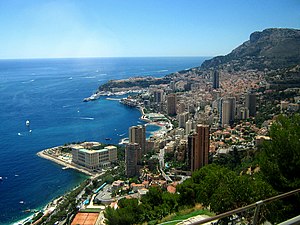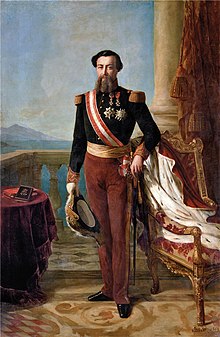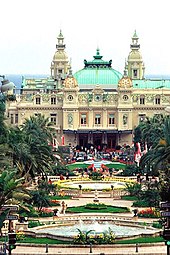Monte Carlo
Monte Carlo | |
|---|---|
Quarter and Ward of Monaco | |
 Early-August 2006 view of Monte Carlo (and Monaco) from the east | |
 Monte Carlo in Monaco (Ward shown) | |
| Country | |
| Government | |
| • Type | Principality |
| Area | |
| • Urban | 0.61 km2 (.234 sq mi) |
| Population (34) | |
• Quarter and Ward of Monaco | 15,200 (in the quarter) 3,500 (in the ward) |
| Postcode | 98000 |
Monte Carlo /ˈmɒnti ˈkɑːrloʊ/ (Italian pronunciation: [ˈmonte ˈkarlo]; Template:Lang-fr, pronounced [mɔ̃te kaʁlo], or colloquially Monte-Carl, pronounced [mɔ̃te kaʁl]; Monégasque: Monte-Carlu) officially refers to an administrative area of the Principality of Monaco, specifically the ward of Monte Carlo/Spélugues, where the Monte Carlo Casino is located. Informally the name also refers to a larger district, the Monte Carlo Quarter (corresponding to the former municipality of Monte Carlo), which besides Monte Carlo/Spélugues also includes the wards of La Rousse/Saint Roman, Larvotto/Bas Moulins, and Saint Michel. The permanent population of the ward of Monte Carlo is about 3,500, while that of the quarter is about 15,000. Monaco has four traditional quarters. From west to east they are: Fontvieille (the newest), Monaco-Ville (the oldest), La Condamine, and Monte Carlo.
Monte Carlo (literally "Mount Charles") is situated on a prominent escarpment at the base of the Maritime Alps along the French Riviera. Near the western end of the quarter is the world-famous Place du Casino, the gambling center which has made Monte Carlo "an international byword for the extravagant display and reckless dispersal of wealth".[1] It is also the location of the Hôtel de Paris, the Café de Paris, and the Salle Garnier (the casino theatre which is the home of the Opéra de Monte-Carlo).
The eastern part of the quarter includes the community of Larvotto with Monaco's only public beach, as well as its new convention center (the Grimaldi Forum), and the Monte-Carlo Bay Hotel & Resort. At the quarter's eastern border, one crosses into the French town of Beausoleil (sometimes referred to as Monte-Carlo-Supérieur), and just 5 miles (8 km) to its east is the western border of Italy.
History

By the 1850s Monaco's reigning family was almost bankrupt; this was a result of the loss of two towns, Menton and Roquebrune, which had provided most of the principality’s revenues with their lemon, orange and olive crops.[2] At the time, a number of small towns in Europe were growing prosperous from the establishment of casinos, notably in German towns such as Baden-Baden and Homburg.
In 1856 Charles III of Monaco granted a concession to Napoleon Langlois and Albert Aubert to establish a sea-bathing facility for the treatment of various diseases, and to build a German-style casino in Monaco.[2] The initial casino was opened in La Condamine in 1862, but was not a success; its present location in the area called "Les Spélugues" (The Caves) of Monte Carlo, came only after several relocations in the years that followed. The success of the casino grew slowly, largely due to the area's inaccessibility from much of Europe. The installation of the railway in 1868, however, brought with it an influx of people into Monte Carlo and saw it grow in wealth.[2]
Saint-Charles Church on Monte Carlo's Avenue Sainte-Charles was completed in 1883. It was restored in its centenary year.[3][4]
In 1911 when the Constitution divided the principality of Monaco in three municipalities, the municipality of Monte Carlo was created covering the existing neighborhoods of La Rousse/Saint Roman, Larvotto/Bas Moulins and Saint Michel. The municipalities were merged into one in 1917, after accusations that the government was acting according to the motto "divide and conquer" and they were accorded the status of wards (quartiers) thereafter. Today, Monaco is divided into 10 wards, with an eleventh ward planned (but currently postponed) to encompass land reclaimed from the sea (see the "Administrative Divisions" section of Monaco for additional details).
The quarter of Monte Carlo was served by tramways from 1900 to 1953, linking all parts of Monaco (see transportation in Monaco). In 2003 a new cruise ship pier was completed in the harbour at Monte Carlo.
Climate
| Climate data for Monte Carlo, Monaco | |||||||||||||
|---|---|---|---|---|---|---|---|---|---|---|---|---|---|
| Month | Jan | Feb | Mar | Apr | May | Jun | Jul | Aug | Sep | Oct | Nov | Dec | Year |
| Mean daily maximum °C (°F) | 12.5 (54.5) |
13.1 (55.6) |
14.5 (58.1) |
16.7 (62.1) |
19.8 (67.6) |
23.3 (73.9) |
26.4 (79.5) |
26.6 (79.9) |
24.2 (75.6) |
20.8 (69.4) |
16.2 (61.2) |
13.5 (56.3) |
19.0 (66.2) |
| Daily mean °C (°F) | 8.7 (47.7) |
9.4 (48.9) |
10.9 (51.6) |
13.2 (55.8) |
16.4 (61.5) |
19.9 (67.8) |
22.9 (73.2) |
23.0 (73.4) |
20.5 (68.9) |
17.0 (62.6) |
12.4 (54.3) |
9.6 (49.3) |
15.3 (59.5) |
| Mean daily minimum °C (°F) | 4.9 (40.8) |
5.6 (42.1) |
7.2 (45.0) |
9.7 (49.5) |
13.0 (55.4) |
16.4 (61.5) |
19.3 (66.7) |
19.3 (66.7) |
16.9 (62.4) |
13.2 (55.8) |
8.6 (47.5) |
5.7 (42.3) |
11.7 (53.1) |
| Average precipitation mm (inches) | 82.7 (3.26) |
76.4 (3.01) |
70.5 (2.78) |
62.2 (2.45) |
48.6 (1.91) |
36.9 (1.45) |
15.6 (0.61) |
31.3 (1.23) |
54.4 (2.14) |
108.2 (4.26) |
104.2 (4.10) |
77.5 (3.05) |
768.5 (30.26) |
| Average precipitation days | 6.8 | 6.4 | 6.1 | 6.3 | 5.2 | 4.1 | 1.9 | 3.1 | 4.0 | 5.8 | 7.0 | 6.0 | 62.7 |
| Mean monthly sunshine hours | 148.8 | 152.6 | 201.5 | 228.0 | 269.7 | 297.0 | 341.0 | 306.9 | 240.0 | 204.6 | 156.0 | 142.6 | 2,668.7 |
| Source: Hong Kong Observatory[5] | |||||||||||||
| Climate data for Monaco | |||||||||||||
|---|---|---|---|---|---|---|---|---|---|---|---|---|---|
| Month | Jan | Feb | Mar | Apr | May | Jun | Jul | Aug | Sep | Oct | Nov | Dec | Year |
| Mean daily maximum °C (°F) | 12.25 (54.05) |
12.52 (54.54) |
13.97 (57.15) |
16.13 (61.03) |
19.36 (66.85) |
22.98 (73.36) |
25.78 (78.40) |
25.93 (78.67) |
23.81 (74.86) |
19.9 (67.8) |
16.09 (60.96) |
13.41 (56.14) |
18.51 (65.32) |
| Mean daily minimum °C (°F) | 8.08 (46.54) |
8.16 (46.69) |
9.6 (49.3) |
11.62 (52.92) |
14.83 (58.69) |
18.49 (65.28) |
21.18 (70.12) |
21.51 (70.72) |
19.28 (66.70) |
15.57 (60.03) |
11.91 (53.44) |
9.25 (48.65) |
14.12 (57.42) |
| Average precipitation days | 5.9 | 5.2 | 6.7 | 6 | 5.6 | 2.8 | 1.3 | 2.5 | 4.5 | 7.5 | 7.7 | 6.8 | 62.5 |
| Source: Monaco website[6] | |||||||||||||
Sport and leisure

Monte Carlo is host to most of the Circuit de Monaco, on which the Formula One Monaco Grand Prix takes place. It also hosts world championship boxing bouts, the European Poker Tour Grand Final and the World Backgammon Championship as well as the Monaco International Auto Show (Fr: Salon International de l'Automobile de Monaco[7]), fashion shows and other events. Although the Monte Carlo Masters tennis tournament is billed as taking place in the community, its actual location is in the adjacent French commune of Roquebrune-Cap-Martin. Monte Carlo has been visited by royalty as well as the general public and movie stars for decades. The Monte Carlo Rally is one of the longest running and most respected car rallies; from 1973 to 2008 and again from 2012, it marks the start of World Rally Championship season, having also served as the curtain-raiser for the Intercontinental Rally Challenge between 2009 and 2011. The rally, however, takes place outside the Monte Carlo quarter and is run mostly on French roads.
Monte Carlo is one of Europe's leading tourist resorts, although many of the key tourist destinations are located in other parts of Monaco, including such attractions as Monaco Cathedral, the Napoleon Museum, the Oceanographic Museum and aquarium, and the Prince's Palace, all of which are located in Monaco-Ville.
Salle Garnier
The Opéra de Monte-Carlo or Salle Garnier was built to designs of the architect Charles Garnier, who also designed the Paris opera house now known as the Palais Garnier. Although much smaller, the Salle Garnier is very similar in style with decorations in red and gold, and frescoes and sculptures all around the auditorium. It was inaugurated on 25 January 1879 with a performance by Sarah Bernhardt dressed as a nymph. The first opera performed there was Robert Planquette's Le Chevalier Gaston on 8 February 1879, and that was followed by three more in the first season.
With the influence of the first director, Jules Cohen (who was instrumental in bringing Adelina Patti) and the fortunate combination of Raoul Gunsbourg, the new director from 1883, and Princess Alice, the opera-loving American wife of Charles III's successor, Albert I, the company was thrust onto the world's opera community stage. Gunsbourg had remained for sixty years.
By the early years of the twentieth century, the Salle Garnier was to see such great performers as Nellie Melba and Enrico Caruso in La Bohème and Rigoletto (in 1902), and Feodor Chaliapin in the premiere of Jules Massenet's Don Quichotte (1910). This production formed part of a long association between the company and Massenet and his operas, two of which were presented there posthumously.
Other famous twentieth-century singers to appear at Monte Carlo included Titta Ruffo, Geraldine Farrar, Mary Garden, Tito Schipa, Beniamino Gigli, Claudia Muzio, Georges Thill, and Lily Pons.
Apart from Massenet, composers whose works had their first performances at Monte Carlo included: Saint-Saëns (Hélène, 1904); Mascagni (Amica, 1905); and Puccini (La rondine, 1917). Indeed, since its inauguration, the theatre has hosted 45 world premiere productions of operas. René Blum was retained to found the Ballet de l'Opéra. The "Golden Age" of the Salle Garnier is gone, as small companies with small houses are not able to mount productions that cost astronomical sums. Nonetheless, the present day company still presents a season containing five or six operas.
Twin cities
Campagna, Italy and Ceuta, Spain are Monte Carlo's twin cities.
Hôtel de Paris

The Hôtel de Paris, established in 1864 by Charles III of Monaco, is located on the west side of the Place du Casino in the heart of Monte Carlo. It belongs to the Société des bains de mer de Monaco (SBM), and is part of the elite Palace Grand Hotels in Monaco with the Hotel Hermitage, the Monte-Carlo Beach Hotel on Monte-Carlo Bay Hotel & Resort, the Metropole Hotel and Fairmont hotel.
The hotel has 106 rooms divided into four groups based on type of view, decoration and luxury.[8] The Exclusive City View offers 20 rooms, the Superior Courtyard has 29 large rooms, the Exclusive Sea View 59 and the Exclusive Casino has six.
Additionally there are 74 suites and junior suites which are grouped similarly, offering more luxury than the rooms. There are single and double suites as well as courtyard junior suites and Sea/Casino Junior suites.[8] There is also one Presidential suite.[9]
In film and television
This section needs additional citations for verification. (February 2016) |
Monte Carlo has featured in numerous films and television series, most recently in the 2011 movie of the same name.
The casino featured in the James Bond films Never Say Never Again (1983), and GoldenEye (1995). To Catch a Thief (1954) was an Alfred Hitchcock film with Monte Carlo and its famous casino as the setting and featured Cary Grant and Grace Kelly, the future Princess Grace of Monaco, as the stars. There is a scene in the movie where the-then Grace Kelly drives a car very quickly—and dangerously—along the steep winding roads of Monaco that surround the heights of Monte Carlo; an interesting coincidence to her actual fate in 1982. Monte Carlo was even a location for the late 1960s British London based series Randall and Hopkirk (Deceased) where in the eleventh episode of the series, "The Ghost who Saved the Bank at Monte Carlo", Mike Pratt, Kenneth Cope and Annette Andre went to Monte Carlo to accompany a highly talented elderly woman to gamble inside the casino and waylay a group of thugs (amongst them Brian Blessed). And Grand Prix (1966) was filmed here, which starred James Garner, Eva M. Saint, and Yves Montand.
In 1970, Chevrolet introduced a car called the Chevrolet Monte Carlo which went through six generations of production until 2007. The motor race Monaco World Prix 1 in Monte Carlo also featured in the 2010 film Iron Man 2. Other films such as I Spy, Cars 2 and Monte Carlo use the city as a setting. The video game series Gran Turismo often features Monte Carlo as a location, and the Indie game Monaco: What's Yours is Mine features Monte Carlo as a setting. There are two difficult heists in the endgame that take place in the Casino. The hotel in Monte Carlo, Monaco also made an appearance in the 2012 DreamWorks Animation SKG film Madagascar 3: Europe's Most Wanted.
In 2016 The Bold and the Beautiful featured a number of episodes filmed on location in the city.


Notable residents
This section needs additional citations for verification. (August 2016) |
- Paula Radcliffe (marathon world record holder)

- Jolanda Ceplak (former athlete)

- Daniela Hantuchova (tennis player)

- Markus Hipfl (former tennis player)

- Victoria Azarenka (tennis player)

- Shirley Bassey (singer)

- Bono (singer with U2)

- Jenson Button (Formula One driver)

- Marin Čilić (tennis player)


- David Coulthard (former Formula One driver)

- Novak Đoković (tennis player)

- Grigor Dimitrov (tennis player)

- Mohamed Al-Fayed (ex-Harrods owner)[10]

- Michele Ferrero (Ferrero SpA owner)

- Matthew Goss (professional cyclist)

- Philip Green (entrepreneur)

- Loris Capirossi (former MotoGP rider)

- Thor Hushovd (cyclist)

- Marat Safin (former tennis player)

- Stelios Haji-Ioannou (owner of easyJet)

- Lewis Hamilton (Formula One driver)

- Justin Hayward (singer with The Moody Blues)

- Robert Kubica (former Formula One driver)[11]

- Gina Lollobrigida (actress)

- Gian Carlo Menotti (classical composer)


- Roger Moore (actor)

- Helmut Newton (photographer)


- Mike Oldfield (musician)

- Stefano Pessina (executive chairman of Alliance Boots)


- Milos Raonic (tennis player)[12]


- Edwina Tops-Alexander

- Keke Rosberg (former Formula One driver)


- Nico Rosberg (Formula One driver)

- David Shilling (milliner)

- Ringo Starr (drummer with the Beatles)[13]

- Jeff Wooller (accountant)

- Caroline Wozniacki (tennis player)

- Petra Kvitová (tennis player)

- Bernard Tomic (tennis player)


- Robin Söderling (tennis player)

- Daniel Ricciardo (Formula One driver)

- Felipe Massa (Formula One driver)

- Marc Rosset (former tennis player)

- Richard Dunne (former professional footballer)

- Yanina Wickmayer (tennis player)

- Lucie Safarova (tennis player)

- Justine Henin (former tennis player)

- Andriy Medvedev (tennis player)

- Dominik Hrbaty (former tennis player)

- Karol Kucera (former tennis player)

See also
- Geography of Monaco with suburbs and features
- Madagascar 3: Europe's Most Wanted
- Monte Carlo Casino
- Monaco Heliport
- Monte Carlo method
- Monte Carlo Resort and Casino - hotel and casino in Paradise, Nevada
- Opéra de Monte-Carlo
- Radio Monte Carlo
- Télé Monte Carlo
References
- ^ "Monaco" in The New Encyclopædia Britannica, 15th edition (Chicago, 1991), vol. 8, p. 243.
- ^ a b c "History of Monte Carlo Casino". Craps Dice Control. Retrieved 23 March 2009.
- ^ "Monuments". Visit Monaco - Monuments. Visit Monaco. Retrieved 23 August 2014.
- ^ "English Community". Saint-Charles Church. Retrieved 25 August 2014.
- ^ "Climatological Information for Monte Carlo, Monaco" - Hong Kong Observatory
- ^ "Monaco - Climat / Pratique / Site officiel de Monaco". Monaco website. Retrieved 17 August 2013. Template:Link language
- ^ "1er Salon International de l'Automobile de Monaco - 2017". 1er salon international de l'automobile de Monaco (in French). Retrieved 4 April 2016.
- ^ a b "Luxury hotel rooms and luxurious suites in the Hotel de Paris". En.hoteldeparismontecarlo.com. Retrieved 2 July 2010.
- ^ "Palace Hotel de Paris in Monte-Carlo". En.hoteldeparismontecarlo.com. Retrieved 2 July 2010.
- ^ "ExclusiveGP". ExclusiveGP.
- ^ Grupa Wirtualna Polska. "Formuła 1". sportowefakty.wp.pl.
- ^ http://www.daviscup.com/en/players/player/profile.aspx?playerid=100052417
- ^ World Entertainment News Network. "Ringo Moves To Monte Carlo To Avoid Tax Laws". Contactmusic.com.

